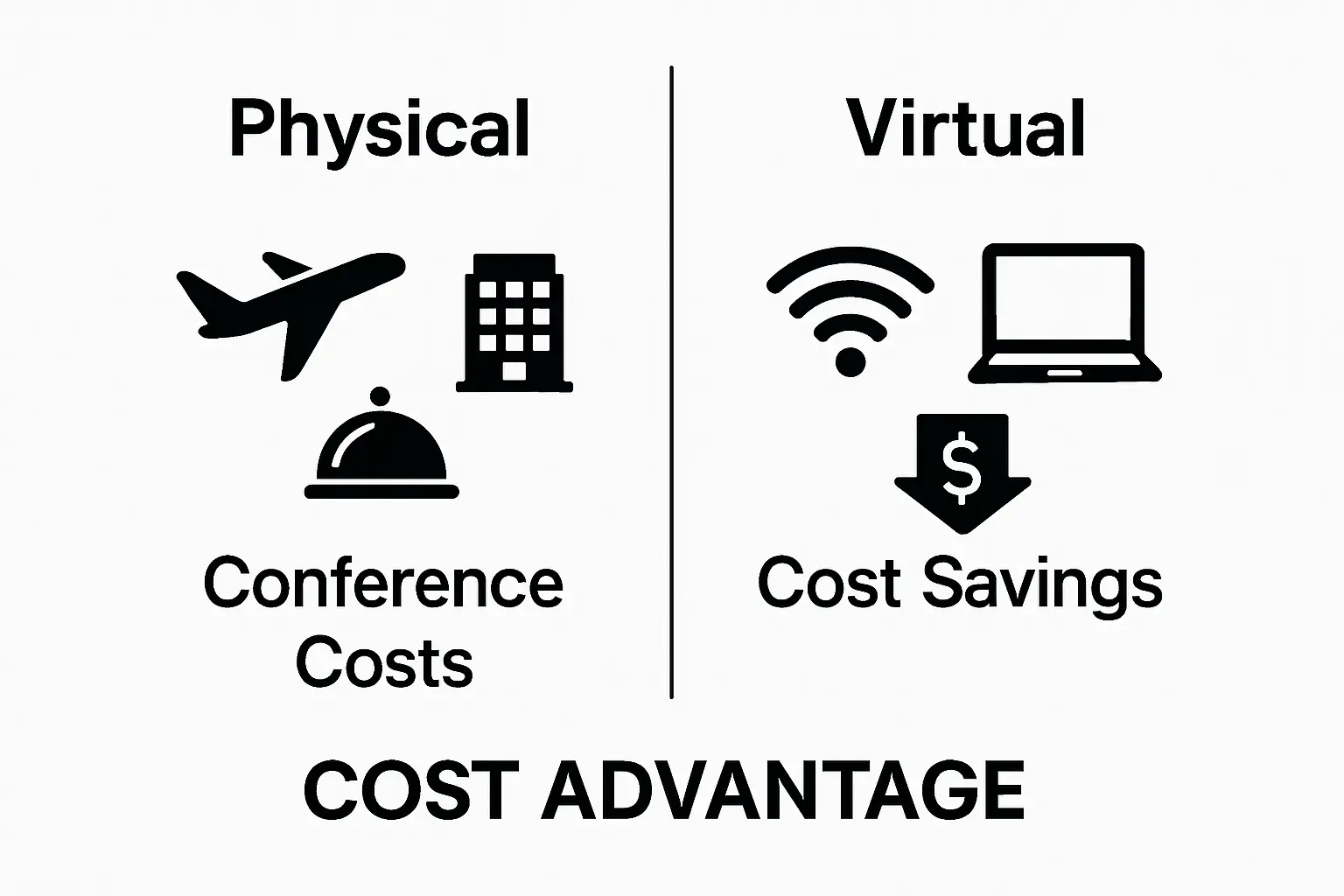Understanding the Benefits of Virtual Conferences

Virtual conferences have rapidly become the backbone of professional and academic events, connecting thousands of people from opposite ends of the globe. Most would expect an online event to feel limited or impersonal. Yet one event shattered expectations when the American Society for Nutrition’s annual meeting jumped from 3,157 in-person attendees to an astonishing 30,000 participants from 167 countries as soon as it went virtual. This shift proves digital gatherings have the power to connect more people than ever before and redefine what participation really means.
Table of Contents
- What Are Virtual Conferences And How Do They Function?
- Key Advantages Of Hosting Virtual Conferences
- Why Virtual Conferences Matter In Today’s Digital World
- How Virtual Conferences Enhance Participation And Engagement
- Real-World Examples Of Successful Virtual Conferences
Quick Summary
| Takeaway | Explanation |
|---|---|
| Virtual conferences enhance global participation. | These events allow professionals from various regions to connect without geographical constraints, promoting inclusivity. |
| Cost savings are significant for organisations. | Virtual formats reduce expenses related to venues, travel, and materials, making them economical. |
| Interactive tools boost engagement levels. | Features like live chats and polls encourage active participation, transforming learning experiences. |
| Flexible access supports diverse schedules. | Attendees can join live sessions or access recorded content, catering to different availability and time zones. |
| Sustainability benefits are notable. | Reducing travel needs lowers carbon emissions, aligning with modern organisational sustainability practices. |
What are Virtual Conferences and How Do They Function?
Virtual conferences represent innovative digital platforms that enable professional and academic gatherings without physical proximity. These online events replicate traditional conference experiences through interactive digital technologies, connecting participants globally through web-based interfaces.
Understanding Virtual Conference Technologies
Unlike traditional conferences requiring physical travel, virtual conferences utilise sophisticated web platforms that facilitate real-time communication, presentation sharing, and networking. According to research in Medical Education, these digital environments support multiple engagement formats including:
- Live streaming of keynote presentations
- Interactive Q&A sessions
- Breakout discussion rooms
- Digital poster presentations
- Recorded session archives
Digital Infrastructure forms the core of virtual conference functionality. Participants access these events through web browsers or dedicated software applications, connecting via video conferencing tools, chat interfaces, and collaborative platforms. The technological framework ensures seamless interaction across geographical boundaries.
Key Operational Components
Virtual conferences operate through comprehensive digital ecosystems that integrate multiple communication technologies. These platforms typically include registration systems, secure login mechanisms, multimedia presentation tools, and interactive networking features. Our guide on hosting virtual conferences provides deeper insights into technical implementation.
The operational model supports synchronous and asynchronous participation, allowing attendees to engage in real-time sessions or access recorded content at their convenience. This flexibility addresses diverse scheduling needs and time zone constraints, making professional development more accessible worldwide.
The following table summarises core operational components and digital features of virtual conferences as described in the article, helping readers quickly scan the fundamental elements of virtual event platforms.
| Component | Description |
|---|---|
| Registration Systems | Online participant registration, often with customisable access permissions |
| Secure Login Mechanisms | Ensures attendee security through password protection or access codes |
| Multimedia Presentation Tools | Facilitates live streaming, screen sharing, and recording of presentations |
| Interactive Networking Features | Enables digital connections through chat, breakout rooms, and matchmaking algorithms |
| Synchronous Participation | Allows real-time interaction in live sessions |
| Asynchronous Participation | Offers recorded content for on-demand access |
| Multilingual Support | Provides translation and language accessibility for a global audience |
Key Advantages of Hosting Virtual Conferences
Virtual conferences have transformed professional networking and knowledge sharing by offering unprecedented accessibility, cost-effectiveness, and global connectivity. These digital platforms provide organisations with strategic opportunities to expand their reach and engagement beyond traditional event limitations.
Cost and Accessibility Benefits
One of the most significant advantages of virtual conferences is their substantial economic efficiency. According to research on conference accessibility, these events dramatically reduce organisational expenses by eliminating:

- Physical venue rental costs
- Travel and accommodation expenses
- Catering and logistical expenditures
- Printed materials and physical infrastructure requirements
Moreover, virtual conferences democratise participation by removing geographical and financial barriers. Professionals from diverse backgrounds can now engage in high-quality learning experiences without significant personal investment, promoting global knowledge exchange.
Enhanced Engagement and Networking Capabilities
Digital conference platforms offer sophisticated networking tools that often surpass traditional event interactions.
Interactive features such as breakout rooms, real-time chat functions, and personalised matchmaking algorithms enable more targeted and meaningful professional connections. Our guide on hybrid event planning explores advanced strategies for maximising digital networking opportunities.
Participants can curate their experiences, selecting sessions aligned with their specific interests, accessing recordings for later review, and connecting with global experts instantaneously. This level of customisation and flexibility represents a significant evolution in professional development and knowledge sharing approaches.
Below is a comparison table outlining the key differences between traditional in-person conferences and virtual conferences as highlighted within the article content.
| Feature / Characteristic | In-Person Conferences | Virtual Conferences |
|---|---|---|
| Accessibility | Limited by physical location and travel | Global access regardless of geography |
| Cost | High (venues, travel, catering, etc.) | Significantly reduced organisational costs |
| Engagement Tools | Primarily face-to-face networking | Interactive digital features (live chat, polls, breakout rooms) |
| Flexibility | Fixed schedule, must attend in real-time | Offers both live and on-demand participation, catering to diverse time zones |
| Environmental Impact | High carbon emissions due to travel | Reduces carbon footprint significantly |
| Participation Rates | Limited by venue capacity and logistics | Can support vastly larger and more diverse audiences |
Why Virtual Conferences Matter in Today’s Digital World
In an era of rapid technological transformation, virtual conferences represent more than just an alternative to traditional gatherings. They are a strategic response to evolving professional communication needs, addressing critical challenges of accessibility, sustainability, and global connectivity.
Global Knowledge Exchange and Inclusivity
Modern organisations require platforms that transcend geographical limitations. According to research in medical sciences, virtual conferences are instrumental in creating truly global knowledge ecosystems by:
- Enabling participation from remote and underrepresented regions
- Reducing economic barriers to professional development
- Facilitating instant cross-cultural professional interactions
- Supporting diverse learning and networking opportunities
These digital platforms democratise access to expertise, allowing professionals from various socioeconomic backgrounds to engage with cutting-edge insights and collaborative opportunities.

Environmental and Organisational Sustainability
Virtual conferences contribute significantly to organisational sustainability efforts. By eliminating extensive travel requirements, these digital events dramatically reduce carbon emissions and environmental impact. Technological innovations have made these platforms not just environmentally responsible but also highly efficient. Our guide on remote team management provides additional context on leveraging digital collaboration technologies.
Moreover, virtual conferences represent a forward-thinking approach to professional development, aligning with emerging workplace trends that prioritise flexibility, digital literacy, and global connectivity. They signal an organisation’s commitment to progressive, inclusive, and sustainable professional engagement strategies.
How Virtual Conferences Enhance Participation and Engagement
Virtual conferences have revolutionised professional interactions by introducing innovative engagement mechanisms that transcend traditional event limitations. These digital platforms create dynamic environments where participants can connect, learn, and collaborate with unprecedented flexibility and depth.
Interactive Engagement Technologies
According to research in medical conference participation, virtual conferences enable extraordinary levels of participant interaction through sophisticated digital tools that support:
- Real-time chat functionalities
- Personalised session recommendations
- Interactive polling and survey mechanisms
- On-demand content access
- Multilingual simultaneous translation services
These technological features transform passive observation into active learning experiences, allowing participants to curate their conference journey according to individual preferences and professional development goals.
Flexible Participation Models
Unlike traditional conferences, virtual platforms remove geographical and temporal constraints, enabling professionals to engage with content seamlessly. Asynchronous participation allows attendees to:
- Watch recorded sessions at convenient times
- Revisit complex presentations
- Engage in discussions across different time zones
- Balance professional responsibilities with continuous learning
Our guide on virtual training best practices offers comprehensive insights into maximising digital engagement strategies. By prioritising participant convenience and learning autonomy, virtual conferences represent a significant evolution in professional knowledge exchange.
Real-World Examples of Successful Virtual Conferences
Virtual conferences have demonstrated remarkable potential across diverse professional domains, showcasing their adaptability and transformative capabilities. These digital platforms have not only survived but thrived during global disruptions, proving their strategic value for organisations worldwide.
Academic and Scientific Conference Transformations
According to research on scientific conference adaptations, academic events have experienced extraordinary success in virtual formats. The American Society for Nutrition’s annual meeting exemplifies this transition, expanding from 3,157 in-person participants across 59 countries to an impressive 30,000 participants from 167 countries when moving online.
Key characteristics of successful academic virtual conferences include:
- Comprehensive digital presentation platforms
- Interactive Q&A sessions
- Recorded session archives
- Global accessibility
- Reduced participation barriers
Technology and Professional Conference Innovations
Technology conferences have particularly excelled in virtual environments. The IEEE Conference on Virtual Reality demonstrated how professional events can seamlessly transition to digital platforms, maintaining high-quality technical programming while dramatically expanding global participation. Our guide on remote team collaboration provides additional insights into managing distributed professional interactions.
These successful virtual conferences demonstrate that digital platforms are not mere substitutes for physical events, but powerful tools for knowledge exchange, networking, and professional development that transcend traditional geographical and logistical limitations.
Here is a concise data table displaying the attendance transformation in the American Society for Nutrition’s annual conference, clearly illustrating the impact of the shift from in-person to virtual formats.
| Event | In-Person Attendance | Virtual Attendance | Countries Represented (Virtual) |
|---|---|---|---|
| American Society for Nutrition Annual Meeting | 3,157 | 30,000 | 167 |
Take Your Virtual Conferences Further with Colossus Systems
Are you feeling limited by the technology and engagement tools in your current virtual conference experience? The article highlighted the growing need for more accessible, interactive, and cost-effective digital events. Yet, for many membership-based organisations, the real challenge is delivering seamless experiences that attract new members, provide rich networking, and support continuous growth. Concepts such as digital infrastructure, asynchronous participation, and flexible engagement are crucial—but difficult to achieve without the right platform.

Let Colossus Systems remove these obstacles for your organisation. Our all-in-one solution lets you create immersive virtual events, manage attendees with ease, and deliver targeted communication that truly connects. Imagine a system where live streaming, event registration, and member engagement all work together, giving you insights and control from one place. Do not let technical frustration or missed connections hold your organisation back. Act now to discover how our platform transforms virtual conferences into powerful opportunities for growth. Connect with our team through our contact page and unlock creative digital engagement today.
Frequently Asked Questions
What is a virtual conference?
Virtual conferences are digital platforms that facilitate professional and academic gatherings online, replicating traditional conference experiences through web-based technologies.
What are the advantages of hosting virtual conferences compared to in-person events?
Virtual conferences offer significant cost savings, increased accessibility, and enhanced engagement opportunities, allowing global participation without the need for physical travel.
How do virtual conferences facilitate networking?
Virtual conferences use advanced interactive tools such as breakout rooms, real-time chat functions, and personalised matchmaking to enable targeted and meaningful professional connections.
Can attendees participate asynchronously in virtual conferences?
Yes, virtual conferences allow for asynchronous participation, enabling attendees to access recorded sessions at their convenience, thereby accommodating diverse schedules and time zones.
Recommended
- How to Host Virtual Conferences: A Step-by-Step Guide|CS
- 8 Creative Remote Team Building Ideas for Your Organisation|CS
- Virtual Training Best Practices for Membership Groups 2025|CS
- How to Host Webinars Effectively for Engagement | Colossus Systems
- How to Schedule the BEST VIRTUAL School Assemblies - Academic Entertainment
- AI Engineering Community Benefits: Accelerate Your Career Through Collaborative Learning